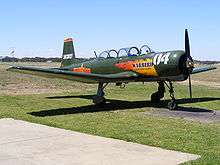Nanchang CJ-6
| CJ-6 | |
|---|---|
 | |
| A Nanchang CJ-6A | |
| Role | Basic Trainer |
| Manufacturer | China Nanchang Aircraft Manufacturing Corporation |
| First flight | August 27, 1958 |
| Introduction | 1960 |
| Status | Operational |
| Primary user | Chinese People's Liberation Army Air Force |
| Number built | 2,000+ |
|
| |
The Nanchang CJ-6 is an aircraft designed and built in China for use by the People's Liberation Army Air Force (PLAAF) as a basic trainer.
Development
The CJ-6 (translation 初教 or CJ = 初级教练机 or Chuji Jiaolianji = Primary Trainer in English) is an all-original Chinese design that is commonly mistaken for a Yak 18A. Its predecessor, the Nanchang CJ-5, was a licence-built version of the Yak-18. However, advancements in pilot training brought a need for a new aircraft with improved performance and a tricycle landing gear. When the Soviet Union developed the Yak-18A, PLAAF engineers decided that its performance and design would not suit China's needs. A few important Chinese aircraft designers were involved in design task of CJ-6, Lin Jiahua (Nanchang 320 Aircraft Factory designer, previously involved in CJ5's design project), Xu Xunshou (key member of J-7/J-8 fighter jet design team in the 1970s) and Zhiqian Huang (Chief designer of J-8 fighter jet).[1]
During late 1957 Aeronautical Engineers Cheng Bushi and Lin Jiahua began work in Shenyang on a trainer design that addressed the shortcomings of the Yak-18A. The design they delivered featured an aluminum semi-monocoque fuselage, flush-riveted throughout, and introduced a modified Clark airfoil wing design with pronounced dihedral in the outer sections. The dihedral and an angular vertical tail distinguish it externally from the otherwise rather similar Yak-18A. Wind tunnel testing validated the design, and in May 1958 the program was transferred to the Nanchang Aircraft Manufacturing factory where Chief Engineer Goa Zhenning initiated production of the CJ-6. The first flight of the CJ-6 was completed on August 27, 1958 by Lu Maofan and He Yinxi.
Power for the prototype was provided by a Czech-built horizontally-opposed piston engine, but flight testing revealed the need for more power, so a locally manufactured version of the Soviet AI-14P 260 hp radial, the Housai HS-6, was substituted along with a matching propeller, and with that change the CJ-6 was approved for mass production. In 1965 the HS-6 engine was upgraded to 285 hp and redesignated the HS-6A, and the aircraft equipped with the new powerplant were designated the CJ-6A.
A total production run estimated at more than 3,000 aircraft supplied CJ-6 aircraft for PLAAF training, as well as for export (as the PT-6) to countries including Albania, Bangladesh, Cambodia, North Korea, Tanzania, and Sri Lanka.
It is expected Hongdu/Yakovlov joint developed CJ-7 Trainer (L-7) primary trainer will replace CJ-6s in PLAAF.
General information
One thing to note is that the Nanchang CJ-6 makes extensive use of pneumatics to control the gear and flap extension/retraction, operate the brakes and start the engine. An engine-driven air pump recharges the system; however if air pressure is too low to start the engine then the onboard air tank can be recharged by an external source. If an external source is not available then the engine can be started by hand swinging the propeller.
Variants


- Hongzhuan-502 (Hongzhuan - Red Craftsman)
- Initial designation of production CJ-6 aircraft.
- CJ-6
- Two-seat primary trainer aircraft, powered by a 260-hp Zhuzhou Huosai HS-6 radial piston engine.
- CJ-6A
- Improved version, powered by a 285-hp Zhuzhou Huosai HS-6A radial piston engine.
- CJ-6B
- Two-seat armed border patrol aircraft, powered by a 300-hp Zhuzhou Huosai HS-6D radial piston engine. Small number built.
- BT-6
- Export designation of the CJ-6 and CJ-6A.
- PT-6A
- Export version of the CJ-6A
- Haiyan A (Haiyan - Petrel)
- Haiyan Prototype. First flew on August 17, 1985.
- Haiyan B
- Single-seat agricultural topdressing, aerial spraying, fire-fighting aircraft, fitted with an upgraded 345-hp Huosai HS-6 radial piston engine.
- Haiyan C
- General aviation variant for agriculture and leisure flight.
Operators
- Ecuadorian Army Aviation [2]
Civilian Use
Due to its low price and sturdy construction, the CJ-6A is a popular hobby plane. A used CJ-6 in the United States can cost as little as $75,000.[3] The aircraft appears on the civil register of the USA, Australia, New Zealand, UK, South Africa and other countries.
In Australia CJ6 Aircraft are generally operated in the Limited Category. This is administered by the Australian Warbirds Association Limited ( AWAL). The AWAL operates under an approval from the Australian Government's Civil Aviation Safety Authority (CASA) to manage the operation of ex Military aircraft.
Specifications (CJ-6A)
Data from Jane's Aircraft Recognition Guide [4]
General characteristics
- Crew: Two (student & instructor)
- Length: 8.46 m (27 ft 9 in)
- Wingspan: 10.22 m (33 ft 6 in)
- Height: 3.3 m (10 ft 8 in)
- Empty weight: 1,095 kg (2,414 lb)
- Max. takeoff weight: 1,400 kg (3,086 lb)
- Powerplant: 1 × Zhouzhou (SMPMC) HS6A (different variants uses different types) radial engine, 213 kW (285 hp)
Performance
- Never exceed speed: 370 km/h (200 kts, 230 mph)
- Maximum speed: 300 km/h (160 kts, 185 mph) diving speed /h (200 kt)
- Range: 700 km (372 nmi, 425 mi)
- Service ceiling: >6,250+ m (20,500+ ft)
Armament
- 2 x 7.62mm machine guns
- Weapons stations and hardpoints under the wings
- Bombs
- Rocket launchers
See also
- Related development
References
- ↑ "Nanchang CJ-6 trainer key design team members". AirForceWorld.com. Retrieved 15 Aug 2011.
- ↑ http://www.aeroflight.co.uk/waf/americas/ecuador/Army/Ecuador-arav-current_inventory.htm
- ↑ http://www.worldwidewarbirds.com/CJ6_aircraft_for_sale.html
- ↑ Rendall, David (1995). Jane's Aircraft Recognition Guide. Glasgow, UK: HarperCollinsPublishers. p. 505. ISBN 0-00-470980-2.
External links
| Wikimedia Commons has media related to Nanchang CJ-6. |
- Warbird Alley: CJ-6 page
- CJ-6 photos and development review, Chinese language
- Warbird Registry: Nanchang CJ-5/CJ-6 Registry
| ||||||||||||||||||||||||||||||||||||||
| ||||||||||||||||||||||||||||||||||||||||||||||||||||||||||||||||||||||||||||